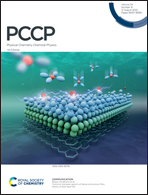Preparation of transmittance-switchable composites from a coexistent system of polymer-dispersed and polymer-stabilized cholesteric liquid crystals†
Abstract
Polymer-dispersed and polymer-stabilized liquid crystals (PD&PSLCs) are the coexistent systems of PDLCs and PSLCs, in which a mesogenic polymer network forms in the LC droplets to construct the PSLC system and the combination of the LC domains and the isotropic polymer matrix makes up the PDLC system. In this work, a PD&PS cholesteric LC (PD&PSCLC) system, where the isotropic polymer walls make up the PDCLC microstructure and the liquid crystalline polymer network in the CLC droplets constructs the PSCLC system, is fabricated successfully. The CLCs are composed of a negative dielectric anisotropy nematic LC and a chiral dopant. Owing to the stabilizing effect of the liquid crystalline polymer network, the planar texture of the CLCs can be retained after the preparation process, and the PD&PSCLC sample is in a large-transmittance state. The action of a low-frequency electric field induces the disordered texture of the CLCs and the light-scattering (low-transmittance) state because of the electro-hydrodynamic effect and dynamic scattering effects. After the removal of the low-frequency electric field, the stabilizing effect of the liquid crystalline polymer network induces the CLC molecules to return to the homogeneous orientation state, and the sample also re-obtains the large transmittance. This work may provide a facile approach to fabricating polymer/CLC composites with switchable transmittance for reverse-mode smart windows.



 Please wait while we load your content...
Please wait while we load your content...